What has Palm Oil got to do with Fashion?

It’s not often that large global corporations, pull the plug on scandals which could impact consumerism and most of all profit; especially if the results could affect the revenue of their own enterprises.
Which is why when Iceland put out the politically taunted palm oil advert – which later got banned, (click here to watch), they revealed to the nation the day by day endangerment we contribute to rainforests across Malaysia, Indonesia and many other neighbouring territories, all for a slice of our favourite frozen dinners.
Yet despite your dietary preferences or lifestyle choices, in this day and age of planet self-deconstruction, I’m sure we can all agree we need transparency as to where and how products we use on a daily basis are being sourced, and to what extent? Which is why myself and probably more clueless millennials were shocked to uncover after a bit of subtle digging, that the oil of the economy, is connected to our stylish new threads, designer and high street alike.
But before we get comfy, let’s clarify what palm oil is, and how it affects our animal kingdom.

‘Palm oil is an edible vegetable oil derived from the mesocarp of the fruit of the oil palms, primarily the African oil palm Elaeis guineensis, and to a lesser extent from the American oil palm Elaeis oleifera and the maripa palm Attalea maripa. 66 million tons of palm oil are produced annually in the EU, making it the most used vegetable-derived oil. Because of its low to source prices, it means it is currently used in half of all supermarket products, especially processed food, which explains why we can get our favourite frozen pizza for around £1 in most places. Palm oil can be found in biscuits, margarine, frozen pizza, and in terms of non-edibles body creams, soaps, makeup, candles and detergents. Another huge import of palm oil is for the use of biofuel’ defines Wikipedia. Concluding palm oil is a modern economy obsession. 66 million tones is the equivalent of 59874192840 kg, which is a close equivalent to the weight of 10 billion people. That’s an outrageous amount of oil.


But how is palm oil destroying our planet, and what’s fashion got to do with it? According to The Rainforest Rescue Organisation,
‘Day after day, huge tracts of rainforest in Southeast Asia, Latin America and Africa are being bulldozed or torched to make room for more plantations, releasing vast amounts of carbon into the atmosphere. As a consequence, Indonesia – the world’s largest producer of palm oil – temporarily surpassed the United States in terms of greenhouse gas emissions in 2015. With their CO2 and methane emissions, palm oil-based biofuels actually have three times the climate impact of traditional fossil fuels. Palm oil is not only bad for the climate: As their forest habitat is cleared, endangered species such as the orangutang, Borneo elephant and Sumatran tiger are being pushed closer to extinction. Smallholders and indigenous people who have inhabited and protected the forest for generations are often brutally driven from their land. In Indonesia, more than 700 land conflicts are related to the palm oil industry. Human rights violations are everyday occurrences, even on supposedly “sustainable” and “organic” plantations.’

Furthermore US business magazine Fast Company explain, ‘If you look at the tags inside your clothing, you’ll often see “rayon” or “viscose.” An increasingly popular fabric–production has doubled in the past decade–these man-made cellulosic fibres are versatile, with a beautiful drape, and a soft and silky feel. They’re also often marketed as more eco-friendly, since they’re made from plant materials instead of plastics like polyester or nylon. But rayon, viscose, and modal have a dark secret: They’re often made from old-growth trees from endangered rainforest’.
Did you know that?
I sure didn’t. Which is why it’s very important as a society despite our varied beliefs, to share, be aware and acknowledge what we are using and how. We as consumers deserve to know what we are buying into, so we can actively make a choice to be a part of something or completely rebuke it, depending on if it aligns with our beliefs or not.
Corporate companies take note, it is up to you, to be honest, and not just profit of marginalised communities and secrets as after all, we are the generation of uncovering secrets.




![ZINO VINCI’S ‘FILTHY & DISGUSTING’EP BRINGS YOU TO THE CORE OF THE ARTIST [@ZinoVinci]](https://guap.co/wp-content/uploads/2023/10/Zino-4.jpg)



